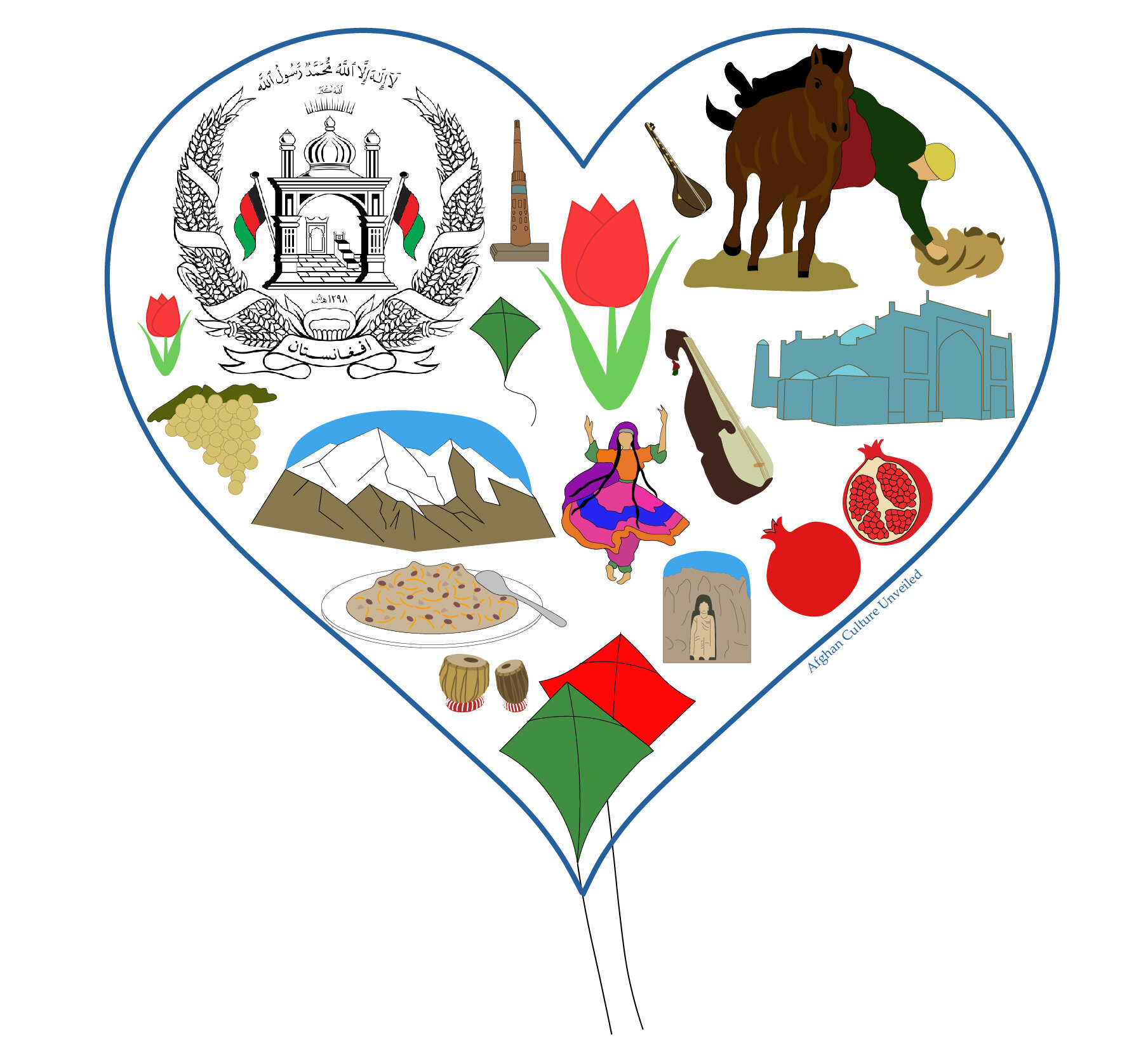by Humaira,
Many of us have been anxiously awaiting the one-year anniversary of the fall of the elected Afghan government and the takeover of the Taliban. Last week I posted about the current state of Afghan women and the setbacks for human rights since the Taliban took over. But today, I want to share with you the beauty of Afghanistan and not her suffering. No matter what the politics, or who is in power Afghans will always hold on to their beautiful culture through food, hospitality, and pride in their heritage.
I invite you to learn about the beauty of Afghanistan through all the symbols I’ve included in this heart that personify our ancient culture.
Here is how my collaborator Emily Rupright and I made this heart. To begin with, I made a list of items, places, and symbols that I associated with Afghanistan and then used that as a jumping-off point to solicit input from the Afghan community on Facebook on what they associate with Afghanistan. The list of suggestions was long and colorful. It included Istalif pottery, Minaret-e-Ghazni, Bagh-e-Babur, Mawlawna Rumi and many other notable people and symbols which did not make it in the final heart. What I did was choose symbols/items that were suggested numerous times in my crowd-sourced list which I juxtaposed against Afghanistan’s National Symbols List, to make sure that each item in the heart has a cultural significance to a large number of people.
Ahmad Shah Durrani - Father of the nation
Considering there is a long running dispute over cultural misrepresentation and heritage thievery among the different ethnicities in Afghanistan, this is when I raise a white flag to say that this is not meant to be a complete or official representation of Afghanistan but a glimpse into the country and its culture as I identified with my limited outreach.
We used dark blue the color of Lapiz Lazuli, a semi-precious stone mainly found in Afghanistan, as the outline which encases the following symbols of this ‘Afghanistan Heart Symbol’.
Minaret-e-Jam is a UNESCO World Heritage site, located in Western Afghanistan, in the province of Ghor.
Red tulip is the national flower of Afghanistan and the symbol of Nowroz, the Afghan New Year.
Dambura is a lute played mainly in Tajik and Uzbek folk music.
Buzkashi is the national sport of Afghanistan
Afghan green grapes are famous in Central Asia and are a major export, both fresh and dried as green raisins, to neighboring countries.
Hindukush Mountains, an 800-kilometer mountain range that runs through Afghanistan and has been written about in folktales and modern novels.
Afghan woman in traditional clothes doing the Afghan national dance--attan. Traditionally attan was performed by men but now both men and women perform this communal dance at end of a wedding, engagement or and Nowroz celebrations.
Rubab is a lute-like instrument played by trained masters and their students in classic Afghan music. It’s the national instrument of Afghanistan.
Shrine of Hazrat-e-Ali, is one of Afghanistan's most beautiful and most revered mosque, located in Mazar-i-Sharif, in the northern province of Balkh.
Qabili Palau is the national dish of Afghanistan and if you want to make it, I have a fabulous recipe for it.
Buddhas of Bamiyan were two, 6th-century statues carved into the side of a cliff in Bamiyan valley. The historically significant monuments were defaced by the Taliban in 2001 and now they stand as a stark reminder of the cultural and human destruction that could return if the Taliban gain power in Afghanistan.
Pomegranate is the national fruit of Afghanistan and if you want to learn how to deseed one in 30-seconds, watch my Afghan hack video.
Tabla is a pair of hand drums, from the Indian Subcontinent, used as a percussion instrument in most Afghan folk and classical music. Salar Nader is a talented and soughtafter Afghan percussionist who lives in California.
Kite flying is the national pastime for Afghan men and boys but I have to admit, when I was a little girl in Kabul, I dabbled in kite flying with my brothers. I was thrilled when my friend Khaled Hosseini’s book The Kite Runner made Afghanistan’s kite flying scene world famous.
Buzkashi, the national sport of Afghanistan.
Photo by: STEPHEN J. THORNE
I started this blog over eight years ago with an American friend who is a food writer. Our goal was to showcase my family’s Afghan recipes and inspire others to cook Afghan food. Over the years this blog has turned into a source not only for Afghan food recipes but also for information on Afghan culture. Feel free to share this post with anyone who you think would enjoy learning about Afghan culture.
NOTE: I would be happy for any of you to use this image on social media or works you create but please ask permission and credit me and my blog Afghan Culture Unveiled as the source and creator.
Except where otherwise noted, all content on this blog is licensed under the Creative Commons Attribution-NonCommercial-NoDerivs 3.0 Unported license.





